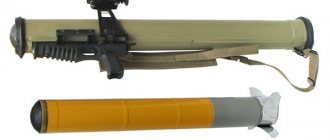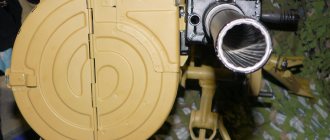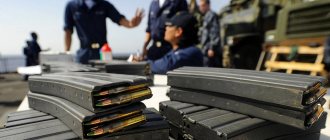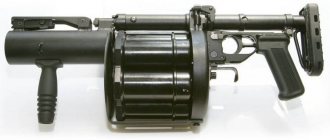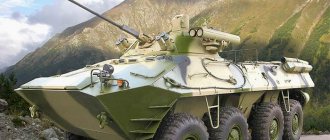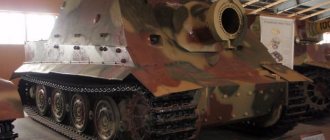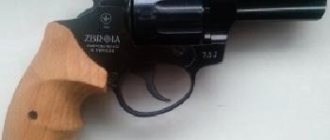Anti-aircraft guns of the ZU-23/30M1 family
It is no secret that regular and timely modernization of weapons and equipment can significantly extend their service life without serious losses in performance and efficiency. In addition, some small and poor states simply do not have the opportunity to purchase completely new weapons, which forces them to look for ways to modernize existing equipment. Several years ago, a new project for modernizing the ZU-23 anti-aircraft gun was created in Russia, which was supposed to be of interest to domestic and foreign customers. The ZU-23/30M1-3 project and its variant ZU-23/30M1-4 were developed by Podolsk Electromechanical. The goal of this project was to create a new version of the outdated ZU-23 anti-aircraft system, suitable for operation in modern conditions. It was proposed to equip the basic anti-aircraft installation with a set of new equipment designed to automate various processes and improve combat performance. The family of modernized anti-aircraft systems received the general designation ZU-23/30M1. At the same time, however, the family currently consists of only two units - ZU-23/30M1-3 and ZU-23/30M1-4. There is no information about the existence of systems with indexes “1” and “2”.
Anti-aircraft gun ZU-23/30M1. Photo Arms-expo.ru
An important feature of the ZU-23/30M1 family of projects is the architecture of the proposed modernized anti-aircraft installation. The base ZU-23 with minimal design changes is used as the basis for the new technology. A set of additional equipment is mounted on it, designed to improve the performance of the basic system. The new equipment includes mechanical guidance drives, control systems, optical-electronic equipment, etc.
The basis of the design of the ZU-23/30M1 family of systems is a platform with wheels and supports. In the stowed position, the unit rests on two wheels and must be towed by a vehicle or other equipment. Upon arrival at the position, during preparation for combat work, the installation is lowered onto three outrigger supports located in the corners of the main platform. The wheels rise and hang above the ground.
The main platform has a rotating mechanism on which the upper platform with the artillery unit, control equipment and operator's workstation is located. The general architecture of the upper platform units has generally remained the same, but has undergone some changes directly related to the addition of new equipment. In the center of the platform there are two automatic guns with vertical guidance systems. Behind them on the left there is an operator’s workplace with a set of necessary controls and systems for monitoring the operation of the installation. To the right of the operator are boxes with other equipment.
Anti-aircraft gun ZU-23/30M1-4, rear view. Photo Pemz-podolsk.ru
The artillery part of the ZU-23 installation does not change when converted into a ZU-23/30M1-3 or ZU-23/30M1-4. Two 2A14 automatic cannons of 23 mm caliber are used as the main means of attacking air and ground targets. The guns use gas-operated automatics and are capable of firing at a rate of up to 800-1000 rounds per minute each. The total rate of fire of the two guns is up to 2000 rounds per minute. The 2A14 guns use 23x152 mm shells. To date, several variants of such ammunition have been created: various operators can use both the Soviet-developed BZT armor-piercing incendiary projectile and other foreign-made projectiles. Two boxes located on the sides of the guns hold 100 shells.
When upgrading to the ZU-23/30M1 state, to the right of the guns, a block of optical-electronic equipment for target detection is installed on a special bracket, capable of swinging in a vertical plane along with the guns. This unit contains a video camera and a thermal imager, which allows the operator to observe and attack detected targets at any time of the day and in any weather conditions. The video signal of the optical-electronic system and other information are displayed on a monitor installed at the operator’s workplace.
Unit of optical-electronic equipment. Photo Pemz-podolsk.ru
An important feature of the ZU-23/30M1-3 and ZU-23/30M1-4 modernization projects was the use of electric drives for the guidance system. The system operator retains the ability to aim the guns manually, however, special electric motors are used as the main way to change the aiming angles. Such mechanisms are controlled using two handles on the operator console located under the monitor. They also house the fire control buttons.
The new equipment of the ZU-23/30M1 family of anti-aircraft systems includes a computing device responsible for the operation of the installation in semi-automatic and automatic modes. New electronics allow the operator to detect aircraft and helicopters at a range of up to 8 km, which significantly exceeds the performance of sighting devices of older models. The developer declared the possibility of aiming guns in manual, semi-automatic and automatic modes. All these modes differ in the distribution of various tasks between the operator and the automation. Thus, it is possible to automatically track a target and calculate lead with control of guidance mechanisms. It is claimed that the use of new equipment makes it possible to increase the efficiency of the installation by an order of magnitude.
To power new electronic equipment on units of the ZU-23/30M1 family, existing batteries or an external source can be used. In the latter case, a generator of suitable power or any other equipment of similar purpose must be placed at the position.
Control panel and bracket for mounting a missile launcher. Photo Pemz-podolsk.ru
The main difference between the ZU-23/30M1-4 system and the ZU-23/30M1-3 is the expanded list of equipment and weapons. This modification is equipped with an additional missile control panel, as well as a launcher for man-portable anti-aircraft missile systems. The installation provides fastenings for mounting two transport and launch containers of Igla missiles or similar systems. Searching for targets and preliminary guidance of missiles is carried out using the existing optical-electronic system. Automation is capable of determining target parameters and giving the operator a recommendation regarding the use of barrel or rocket weapons. After launch, the missiles are aimed independently.
Modernization using new equipment made it possible to maintain some characteristics at the same level, as well as increase a number of other parameters. When using anti-aircraft guns, it is possible to fire at targets at ranges up to 2500 m and at altitudes up to 1500 m. The design of the anti-aircraft gun allows firing in any direction with elevation angles from -5° to +80°. The drives used can point guns in the horizontal plane at speeds of up to 60 degrees per second and at speeds of up to 45 degrees per second in the vertical plane. The reaction time, according to the developer, does not exceed 6 seconds. It is possible to fire at targets moving at speeds up to 400 m/s. Maximum firing efficiency is achieved at target speeds of no more than 200 m/s.
Operator's console and MANPADS launcher. Photo Arms-expo.ru
The ZU-23/30M1-4 anti-aircraft gun, equipped with missile weapons, has great destruction characteristics in terms of range and altitude. The Igla and Igla-S missiles can hit targets at ranges of up to 6 km and altitudes of up to 3.5 km. The speed of the effectively hit target in this case reaches 400 m/s. After firing two missiles on the launcher, installation of new containers takes no more than a few minutes and is carried out by crews.
If necessary, modernized anti-aircraft installations can be used to attack ground targets. In this case, the fire is conducted with a minimum elevation angle of the barrels. The maximum range for hitting ground targets, depending on their type, corresponds to the firing range for air targets. However, the effective firing range directly depends on the type of target. Thus, unprotected vehicles can be effectively hit over the entire range of distances, while armored vehicles should be attacked at a shorter distance. In addition, the effective firing range against armored vehicles depends on the type of shells used.
According to available data, anti-aircraft guns of the ZU-23/30M1 family can operate as part of batteries. In this case, the operator controls one installation with a full set of equipment and interacts with several similar systems in a simplified configuration. The operation of such a battery is controlled by an operator who monitors the air situation and determines targets for attack. In this case, the automation of the “main” installation can issue target designation and commands to other installations that have only guidance drives and fire control systems. This mode of operation can combine up to four anti-aircraft installations into a single structure: one “master” and three “slave”.
Anti-aircraft gun ZU-23/30M1-4 with missiles. Photo Pemz-podolsk.ru
The development company offers customers a whole range of tools designed for the full operation of a modernized anti-aircraft installation. In addition to the actual towed installations ZU-23/30M1-3 or ZU-23/30M1-4, this complex includes a maintenance vehicle, a set of spare parts, as well as training systems for training operators. There is also information about the creation of a special support platform that allows you to mount an anti-aircraft gun in the back of any suitable truck.
In the basic towed version, anti-aircraft guns of the ZU-23/30M1 family are serviced by a crew of five people, including the tractor driver. The weight of the installation, depending on the modification, does not exceed 1260 kg. The design of the unit's chassis allows it to be towed at speeds of up to 70 km/h on the highway and no faster than 30 km/h on a dirt road.
Projects for modernized anti-aircraft guns ZU-23/30M1-3 and ZU-23/30M1-4 were offered to customers at the end of the 2000s. Soon information appeared about the first purchases of such weapons. In the first half of 2011, deliveries of several types of Russian anti-aircraft systems to Venezuela began. A large contract implied the supply of various missile and artillery systems, including ZU-23/30M1-4 installations. According to the Venezuelan press, 300 such systems with the possibility of using anti-aircraft missiles were ordered. The first samples of such weapons were handed over to the customer in May 2011.
Installation of ZU-23/30M1-4 at a parade in Venezuela
On July 5, 2011, Independence Day, a military parade took place in Caracas. During this event, various types of weapons and equipment purchased by Venezuela recently were demonstrated. Among other samples, the ZU-23/30M1-4 anti-aircraft guns in a towed version were shown. Apparently, the parade included equipment supplied as part of one of the first batches.
Information on other contracts for the supply of anti-aircraft guns of the ZU-23/30M1 family is not yet available. Probably, new buyers have not yet shown interest in these systems. However, we can expect that in the near future the Podolsk Electromechanical Plant will receive new orders for such weapons. ZU-23 anti-aircraft guns and their modifications are in service with a large number of countries around the world, which may be interested in modernizing or replacing them, but do not have the opportunity to buy more complex and advanced air defense systems.
Based on materials from the sites: https://pemz-podolsk.ru/ https://arms-expo.ru/ https://vestnik-rm.ru/ https://bmpd.livejournal.com/
30mm aircraft cannon ammunition
Designed to destroy air and ground lightly armored and unarmored targets when firing from 30 mm air cannons GSh-301, GSh-30, GSh-30K and GSh-6-30 aircraft such as Su-27, MiG-29, Mi-24P helicopters, Su aircraft -25 and other media. The range of ammunition provides reliable fragmentation, high-explosive, incendiary, and armor-piercing effects on various targets. Modern projectiles with plastic driving devices increase the service life of gun barrels, reduce their heating during firing, and ensure ballistic stability in all weather and climatic conditions. 30 mm ammunition:
- with a high-explosive fragmentation incendiary projectile;
- with a projectile with ready-made submunitions;
- with an armor-piercing tracer projectile;
- with an armor-piercing projectile.
30-mm rounds with the VOG-30 high-efficiency grenade
The grenade is designed for firing along a flat or mounted trajectory from automatic grenade launchers AGS-17 and AGS-30 to destroy enemy personnel, as well as military equipment. These automatic grenade launchers are in service with motorized rifle units, and modifications of these grenade launchers can be installed on helicopters, motor boats and cars. The grenade is equipped with an instantaneous fuse, which ensures that it will hit the target even when the ammunition hits snow or water. Increased fragmentation effect is ensured by a fragmentation jacket with semi-finished fragments inserted inside. For shooting training, the VUS-30 shot is used.
www.militarypribor.ru
LikeLikeTweet
